链表
链表是的线性表的一个类别,在学习链表之前,让我们先来看看线性表。
TIP
《算法 4》 中并没有涉及到线性表,但是这属于数据结构中非常基础的部分,对于学习链表也非常有价值,因此在这里提出,如果你了解的话,可以直接跳到第 2 小节。
1. 线性表
1.1 线性表
线性表是一组线性存储结构的数据,什么是线性存储结构呢?通俗的理解就是:一组数据存储在物理空间中,可以用“一根线”线性地把它串起来。
比如有这样一组数组:1,2,3,4,5,将其线性的存储起来,有两种方式:
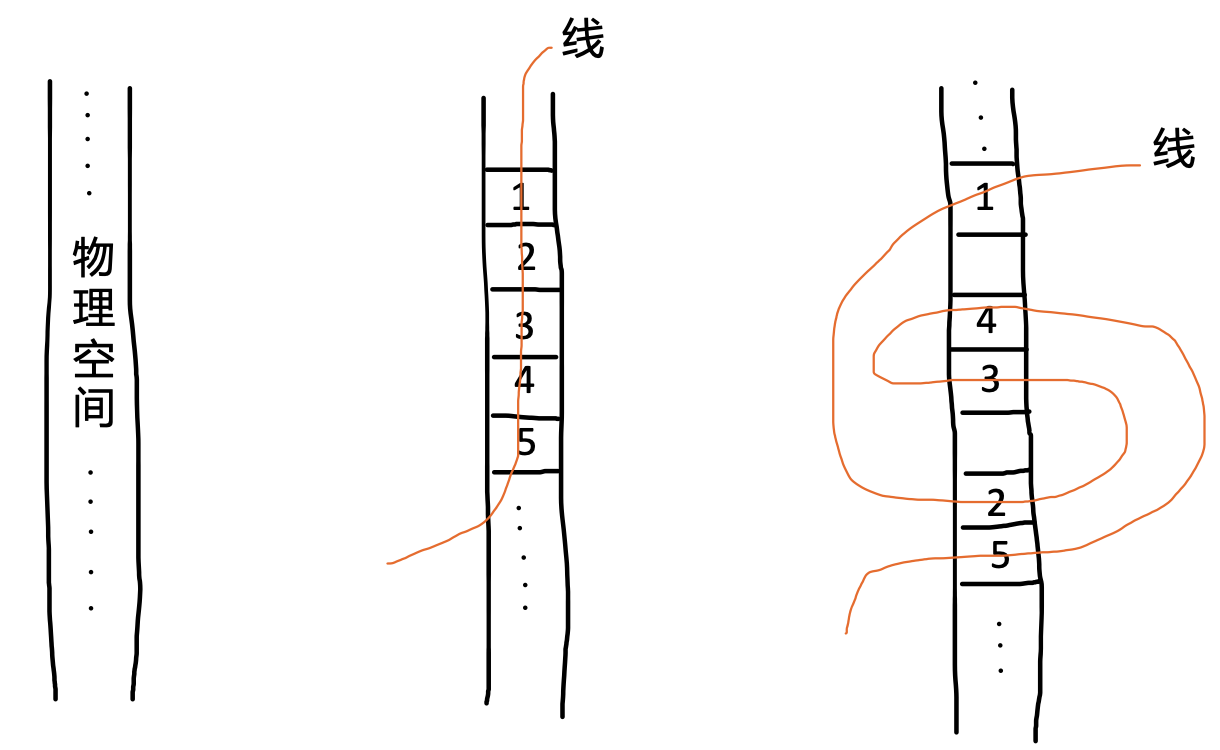
图1:两种存储线性表的方式
这两种方式都是线性存储的,但第一种是按照物理空间依次存储的,第二种是随机存储的。
第一种是多数人想到的存储方式,而第二种却少有人想到。那么数据是否成功地存储了呢?这取决于能否将数据完整地复原成它本来的样子。如果把两种方式的线的一头扯起,就会发现数据的位置次序是没有发生改变的。因此可以认定,这两种存储方式都是正确的。
TIP
线性表的定义和特点的详细说明可以参见:《数据结构(C 语言版本)(第二版)》2.1 线性表的定义和特点
1.2 线性表的顺序存储(顺序表)
线性表的顺序存储指的是用一组地址连续的存储单元依次存储线性表的数据元素,这种表示也称作线性表的顺序存储结构或顺序映像。通常,称这种存储结构的线性表为顺序表(Sequential List)。其特点是,逻辑上相邻的数据元素,其物理次序也是相邻的。
在高级程序设计语言中,通常都用数组来描述数据结构中的顺序存储结构。
1.1 中图 1 的第一种存储方式就是顺序存储结构 —— 顺序表
1.3 线性表的链式存储(链表)
线性表的链式存储的特点是:用一组任意的存储单元存储线性表的数据元素(这组存储单元可以是连续的,也可以是不连续的)。
因此,为了表示每个数据元素 ai 与其直接后继数据元素 ai+1 之间的逻辑关系,对数据元素 ai 来说,除了存储其本身的信息之外,还需存储一个指示其直接后继的信息(即直接后继的存储位置)。这两部分信息组成数据元素 ai 的存储映像,称为结点(node)。
一个结点包括两个域:
- 数据域:存储数据元素信息的域
- 指针域:存储直接后继存储位置的域。指针域中存储的信息称作指针或链。
n 个结点(ai(1≤i≤n)的存储映像)链结成一个链表,即为线性表(a1, a2,…, an)的链式存储结构。又由于此链表的每个结点中只包含一个指针域,故又称线性链表或单链表。
1.1 中图 1 的第二种方式就是链式存储结构 —— 链表
1.4 小结
- 线性表是一种线性存储结构
- 线性表顺序存储就是顺序表
- 线性表链式存储就是链表(可以顺序存储,也可不顺序存储,可连续存储,也可不连续存储)
2. 链表
2.1. 基本定义
定义:链表是一种递归的数据结构,它或者为空(null),或者指向一个结点(node)的引用,该结点含有一个泛型的元素和一个指向另一条链表的引用。
泛型:任意类型数据
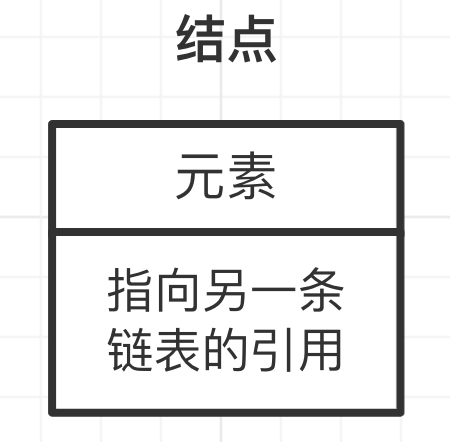
图1:链表结点

图2:链表
2.2. 链表分类
根据链表结点所含指针个数、指针指向和指针连接方式,可将链表分为单链表、循环链表、双向链表、二叉链表、十字链表、邻接表、邻接多重表等。
其中单链表、循环链表和双向链表用于实现线性表的链式存储结构,其他形式多用于实现树和图等非线性结构。
最常见的就是单链表,我们也主要对单链表进行学习。
2.3. 链表基础操作
用 js 表示一个结点
按照结点的定义:
- 含有一个泛型的元素(这里的泛型可以简单的理解为任何类型)
- 指向另一条链表的引用(也就是说,有一个指向另一个结点的值)
jsclass Node { constructor(value = null, next = null) { this.value = value; // 元素 this.next = next; // 指向另一条链表,另一个结点的值 } }TIP
其实定义结点用 ts 更加合适,因为结点的指针指向的要么是一个结点,要么是 null,所以用 ts 更好地实现这样的嵌套类,实现类型的检查。
tsclass LinkNode { value: any; next: LinkNode | null; constructor(value: any = null, next: LinkNode | null = null) { this.value = value; this.next = next; } }创建一条链表
创建一条链表非常的简单,只需要将所有的结点连接起来,就形成了一条链表
- 用定义好的 Node 类创建结点
- 将结点按照期望的顺序连接起来(怎么连接?前一个结点的 next 指向后一个结点即可)
此时:
- first 就是一条拥有三个结点的链表,first 是一个结点的引用,该结点含有一个指向 second 的引用
- second 同样是一个拥有两个结点的链表,second 同样是一个结点的引用,该结点含有一个指向 first 的引用
- third 同样是一个拥有一个结点的链表,third 也是一个结点的引用,该节点指向 null,即空链表
jslet first = new Node('1'); const second = new Node('2'); const third = new Node('3'); first.next = second; second.next = third; console.log(JSON.stringify(first, null, 2)); // { // "value": "1", // "next": { // "value": "2", // "next": { // "value": "3", // "next": null // } // } // }在表头插入结点
非常的简单,总结一句话:新结点的指针指向链表表头即完成在表头插入结点
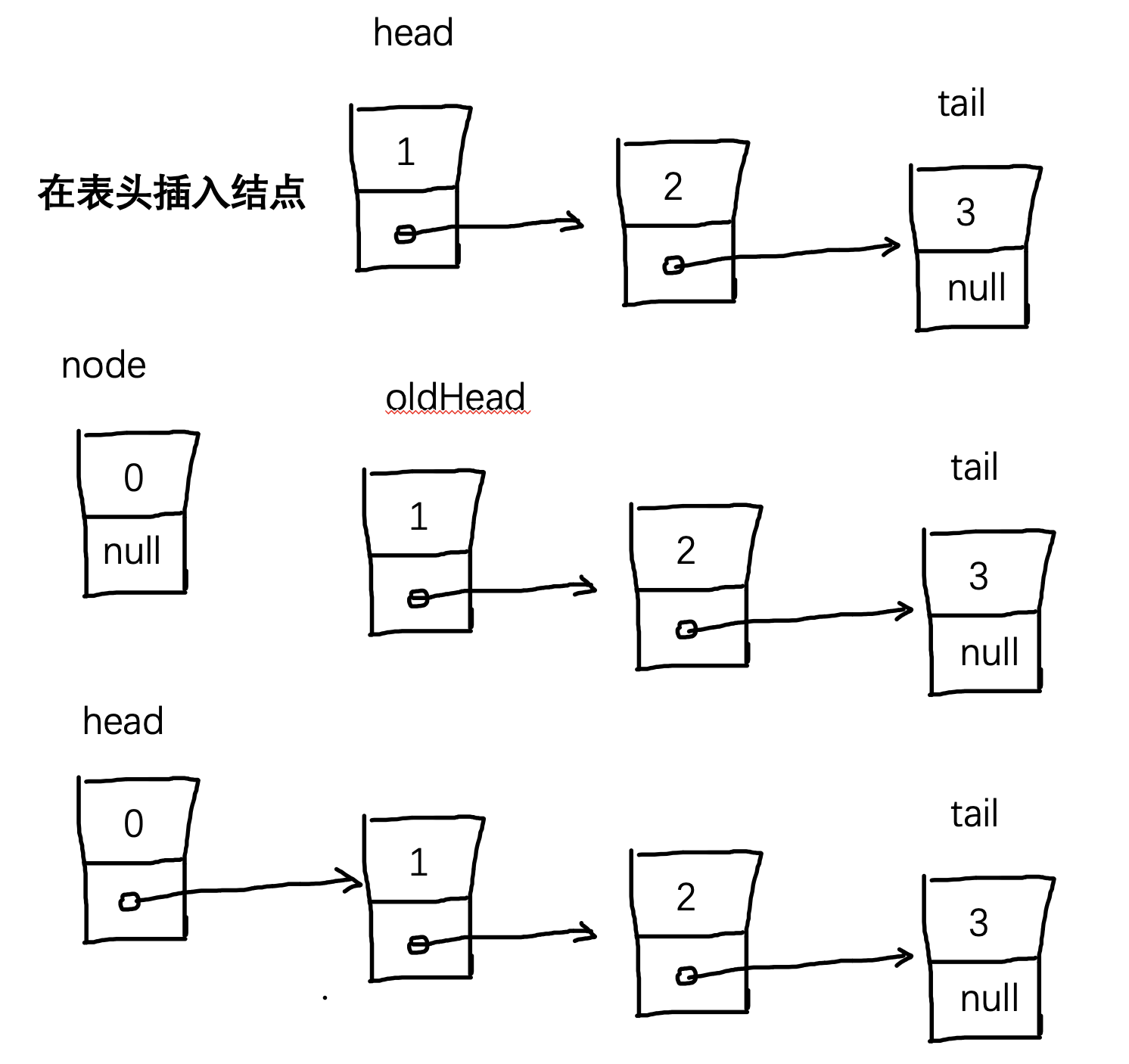
图1:在链表头部插入结点
function insertNodeAtHead(link, node) {
node.next = link;
return node;
}
const insert = new Node('0', null);
first = insertNodeAtHead(first, insert);
console.log(JSON.stringify(first, null, 2));
// {
// "value": "0",
// "next": {
// "value": "1",
// "next": {
// "value": "2",
// "next": {
// "value": "3",
// "next": null
// }
// }
// }
// }删除表头结点
非常的简单,同样总结一句话:表头结点修改为表头的下一个结点即完成表头结点的删除
TIP
删除后,旧的头结点其实并没有直接删除,而是等到内存回收机制来对它进行处理,如果这个结点没有任何地方引用,那么就会清除掉,否者仍然保留
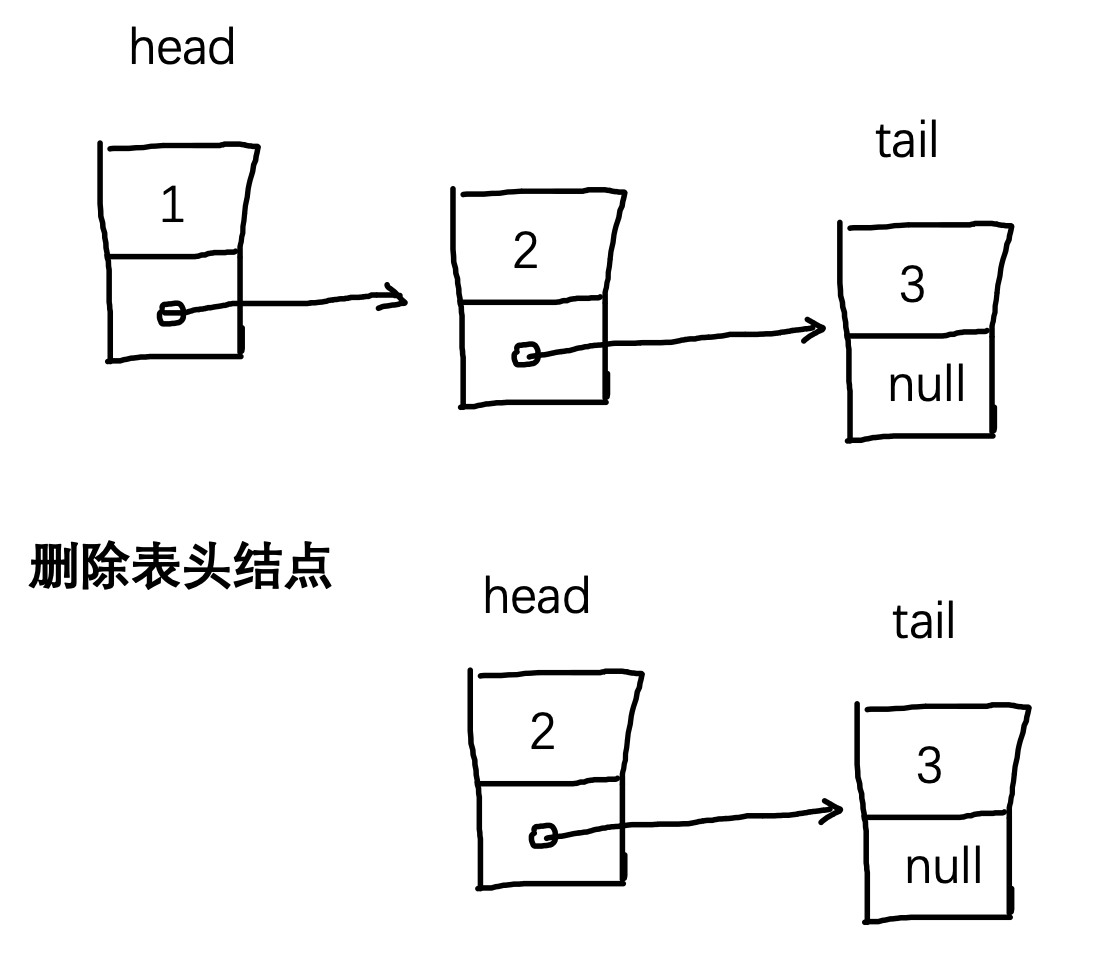
图2:删除链表首结点
jsfunction deleteNodeAtHead(link) { link.value = null; return link.next; } first = deleteNodeAtHead(first); console.log(JSON.stringify(first, null, 2)); // { // "value": "2", // "next": { // "value": "3", // "next": null // } // }在表尾插入结点
非常的简单,同样总结一句话:从表头开始,循环找到尾结点,尾结点的指针指向新结点即完成表尾插入新结点。
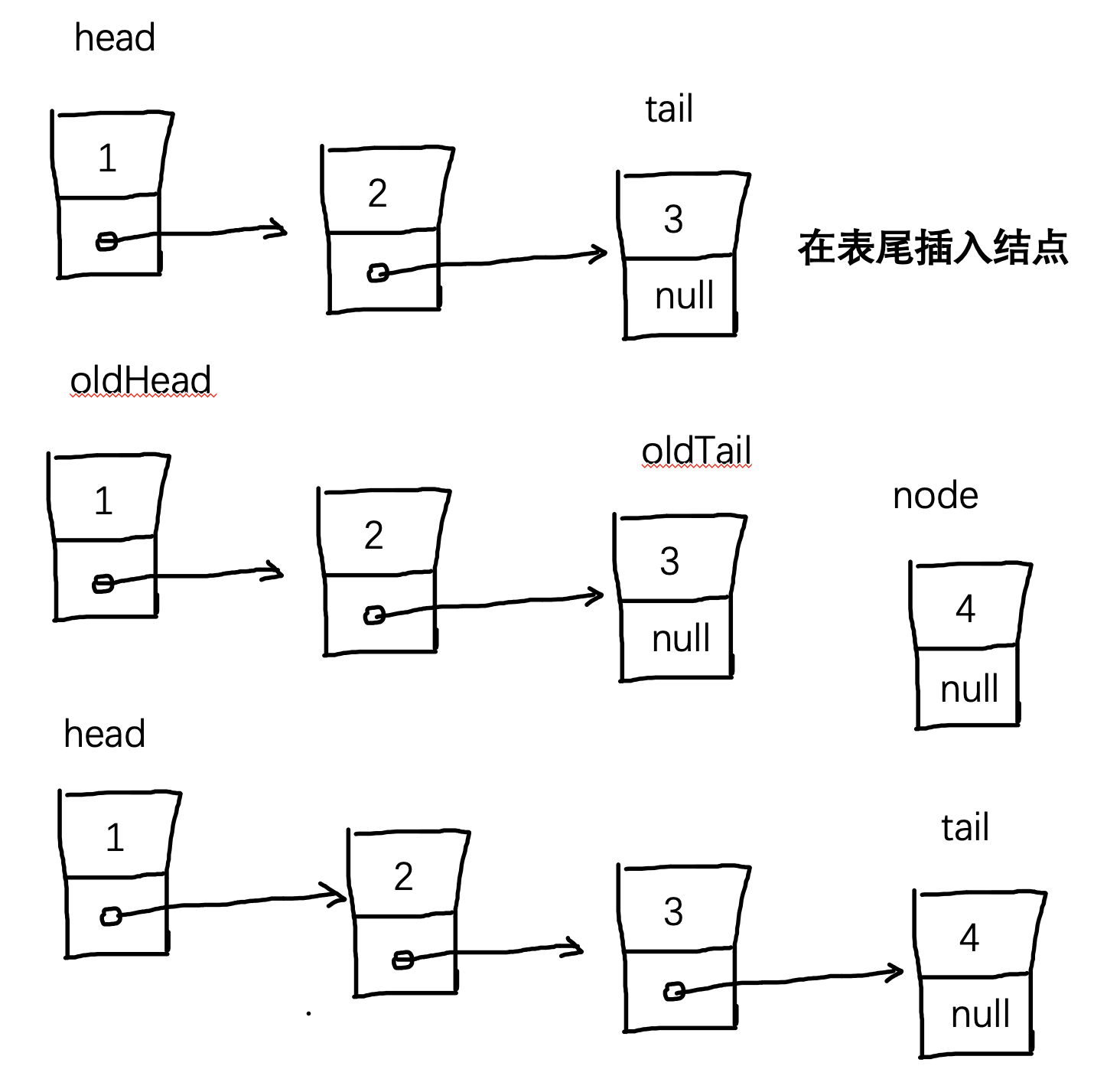
图3:链表结尾插入新结点
关键点就在于:如何找到尾结点。其实非常的简单,一个链表中什么样的结点是尾结点呢?有什么样的特征呢?那就是链表结点的指针域指向 null 的结点便是尾结点。所以,只需要从表头开始,一步一步地往下循环查找,一直查找到某个结点的指针指向 null 停止。
jsfunction insertNodeInTail(link, node) { let p = link; while (p.next !== null) { p = p.next; } p.next = node; } const insert = new Node('4'); insertNodeInTail(first, insert); console.log(JSON.stringify(first, null, 2)); // { // "value": "1", // "next": { // "value": "2", // "next": { // "value": "3", // "next": { // "value": "4", // "next": null // } // } // } // }删除指定结点
参照前面的链表基础操作,作为思考题。
具体的讲解放在了第 3 小节课后习题中。
在指定结点前插入新结点
参照前面的链表基础操作,作为思考题。
具体的讲解放在了第 3 小节课后习题中。
2.4 用链表实现栈和队列
前面我们用数组(顺序表)实现了栈和队列,这里我们用链表同样可以实现。
用链表实现栈相比较队列要简单一些,因此先实现栈
用链表实现栈
实现 LIFO 的 API。
jsclass Node { constructor(value = null, next = null) { this.value = value; this.next = next; } } // LIFO class StackByLink { link = null; // 其实这里也同样应该设置为私有属性的,但为了展示,这里就仍然使用普通属性 #size = 0; // ES2022 正式为 class 添加了私有属性,方法是在属性名之前使用 # 表示。 push(value) { this.#size += 1; this.link = new Node(value, this.link); } pop() { if (this.#size !== 0) { this.#size -= 1; const value = this.link.value; this.link = this.link.next; return value; } return null; } size() { return this.#size; } isEmpty() { return !this.#size; } forEach(cb) { if (typeof cb === 'function') { let p = this.link; while (p !== null) { cb(p.value); p = p.next; } } } } const s = new StackByLink(); s.push(1); s.push(2); s.push(3); console.log('s', s); s.forEach((value) => console.log(value)); const sp = s.pop(); console.log('sp', sp); console.log('s', s);用链表实现队列
同样实现 FIFO 的 API。
jsclass QueueByLink { link = null; #last = null; #size = 0; enqueue(value) { // 链尾添加 if (this.#size === 0) { this.#last = new Node(value, null); this.link = this.#last; } else { const oldLast = this.#last; this.#last = new Node(value, null); oldLast.next = this.#last; } this.#size += 1; } dequeuq() { // 链头删除 if (this.#size !== 0) { this.#size -= 1; const value = this.link.value; this.link = this.link.next; return value; } return null; } size() { return this.#size; } isEmpty() { return !this.#size; } forEach(cb) { if (typeof cb === 'function') { let p = this.link; while (p !== null) { cb(p.value); p = p.next; } } } }
2.5. 小结
数组:顺序存储,数组中是元素
链表:链式存储,链表中是结点
3. 课后习题
假设 x 是一条链表的某个结点且不是尾结点。下面这条语句的效果是什么?
jsx.next = x.next.next;点击查看参考答案
删除 x.next 结点
编写一个方法 delete(),接收一个参数 k,删除链表的第 k 个元素,如果它存在的话
点击查看参考答案
jsfunction deleteKNode(link, k) { if (link === null) throw Error('link is null'); if (k <= 0) throw Error('k should ght 0'); if (k === 1) return link.next; let curr = link; // 找到第 k-1 个结点,因此循环 k-2 次 for (let i = 0; i < k - 2; i++) { curr = curr.next; if (curr.next === null) return link; } curr.next = curr.next.next; return link; } console.log(JSON.stringify(deleteKNode(first, 11), null, 2));假设 x 是一条链表中的某个结点,下面这段代码做了什么?
jst.next = x.next; x.next = t;INFO
t 也是一个结点哈
点击查看参考答案
在 x 结点后添加 t 结点
下面这段代码又做了什么呢?
jsx.next = t; t.next = x.next;点击查看参考答案
x 结点指向了 t 结点,t 结点指向了自己。
编写一个函数,接受一条链表的首结点作为参数,(破坏性地)将链表反转并返回结果链表的首结点
点击查看参考答案
jsfunction reverse_v2(link) { let p = link; let reverse = null; while (p !== null) { const node = p; p = p.next; node.next = reverse; reverse = node; } return reverse; }
4. leetcode 题目
给你单链表的头指针 head 和两个整数 left 和 right,其中 left <= right 。请你反转从位置 left 到位置 right 的链表结点,返回反转后的链表。点击查看 LeetCode 题目
解法 1
点击查看参考答案
jsclass Node { constructor(value = null, next = null) { this.value = value; this.next = next; } } const reverseLink = function (head) { let curr = null; let prev = head; while (prev) { const next = prev.next; prev.next = curr; curr = prev; prev = next; } return curr; }; function reverseBetweenNM(head, left, right) { const dummyNode = new Node(-1, head); // 虚拟头结点 let preLeft = dummyNode; // 左截断结点前一个结点 let leftNode = null; // 左截断结点 let rightNode = null; // 右截断结点 let afterRight = null; // 右截断结点后一个结点 // 1. 获取左截断结点前一个结点 for (let i = 0; i < left - 1; i++) { preLeft = preLeft.next; } // 2. 获取左截断结点 leftNode = preLeft.next; rightNode = leftNode; // 3. 获取右截断结点 for (let i = 0; i < right - left; i++) { rightNode = rightNode.next; } // 4. 获取右截断结点后一个结点 afterRight = rightNode.next; // 5. 反转截断的链表 rightNode.next = null; reverseLink(leftNode); // 6. 左截断结点前一个结点连接上反转后的链表 preLeft.next = rightNode; // 7. 反转后的链表尾结点为左截断结点,结点连接右截断结点后一个结点 leftNode.next = afterRight; // 8. 返回链表 return dummyNode.next; }解法 2
点击查看参考答案
jsfunction reverseBetweenNMBetter(head, left, right) { const dummyNode = new Node(-1, head); // 虚拟头结点 let preLeft = dummyNode; // 左截断结点前一个结点 for (let i = 0; i < left - 1; i++) { preLeft = preLeft.next; } let leftNode = preLeft.next; let rightNode = leftNode; let curr = null; for (let i = 0; i < right - left + 1; i++) { const node = rightNode; rightNode = rightNode.next; node.next = curr; curr = node; } preLeft.next = curr; leftNode.next = rightNode; return dummyNode.next; }解法 3
点击查看参考答案
jsfunction reverseBetweenNMPerfect(head, left, right) { const dummyNode = new Node(-1, head); // 虚拟头结点 let preLeft = dummyNode; // 左截断结点前一个结点 for (let i = 0; i < left - 1; i++) { preLeft = preLeft.next; } let curr = preLeft.next; let leftNode = curr; for (let i = 0; i < right - left; i++) { const next = curr.next; curr.next = next.next; next.next = leftNode; leftNode = next; } preLeft.next = leftNode; return dummyNode.next; }
给你两个单链表的头结点 headA 和 headB ,两条链表可能相交也可能不相交,如果相交请你找出并返回两个单链表相交的起始结点,如果不存在相交结点,返回 null。点击查看 LeetCode 题目
TIP
这道题目是算法里我最喜欢的了,没有之一,至于为什么,看下面的题解 2 就知道了
解法 1
点击查看参考答案
jsconst getIntersectionNode_v1 = function (headA, headB) { let temp = headA; const visited = new Set(); while (temp !== null) { visited.add(temp); temp = temp.next; } temp = headB; while (temp !== null) { if (visited.has(temp)) { return temp; } temp = temp.next; } return null; };解法 2
解题之前让我们来看一个视频,点击查看
这种巧妙的方式是:分别为链表 A 和链表 B 设置指针 A 和指针 B,然后开始遍历链表,如果遍历完当前链表,则将指针指向另外一个链表的头部继续遍历,直至两个指针相遇。
最终两个指针分别走过的路径为:
- 指针 A :a+c+b
- 指针 B :b+c+a
明显 a+c+b = b+c+a,因而如果两个链表相交,则指针 A 和指针 B 必定在相交结点相遇。
解法来自: 教你用浪漫的方式找到两个单链表相交的起始节点
所以如果你够浪漫,算法题都能刷出爱情的味道。
点击查看参考答案
jsconst getIntersectionNode_v2 = function (headA, headB) { if (headA === null || headB === null) return null; let pA = headA, pB = headB; while (pA !== pB) { pA = pA === null ? headB : pA.next; pB = pB === null ? headA : pB.next; } return pA; };